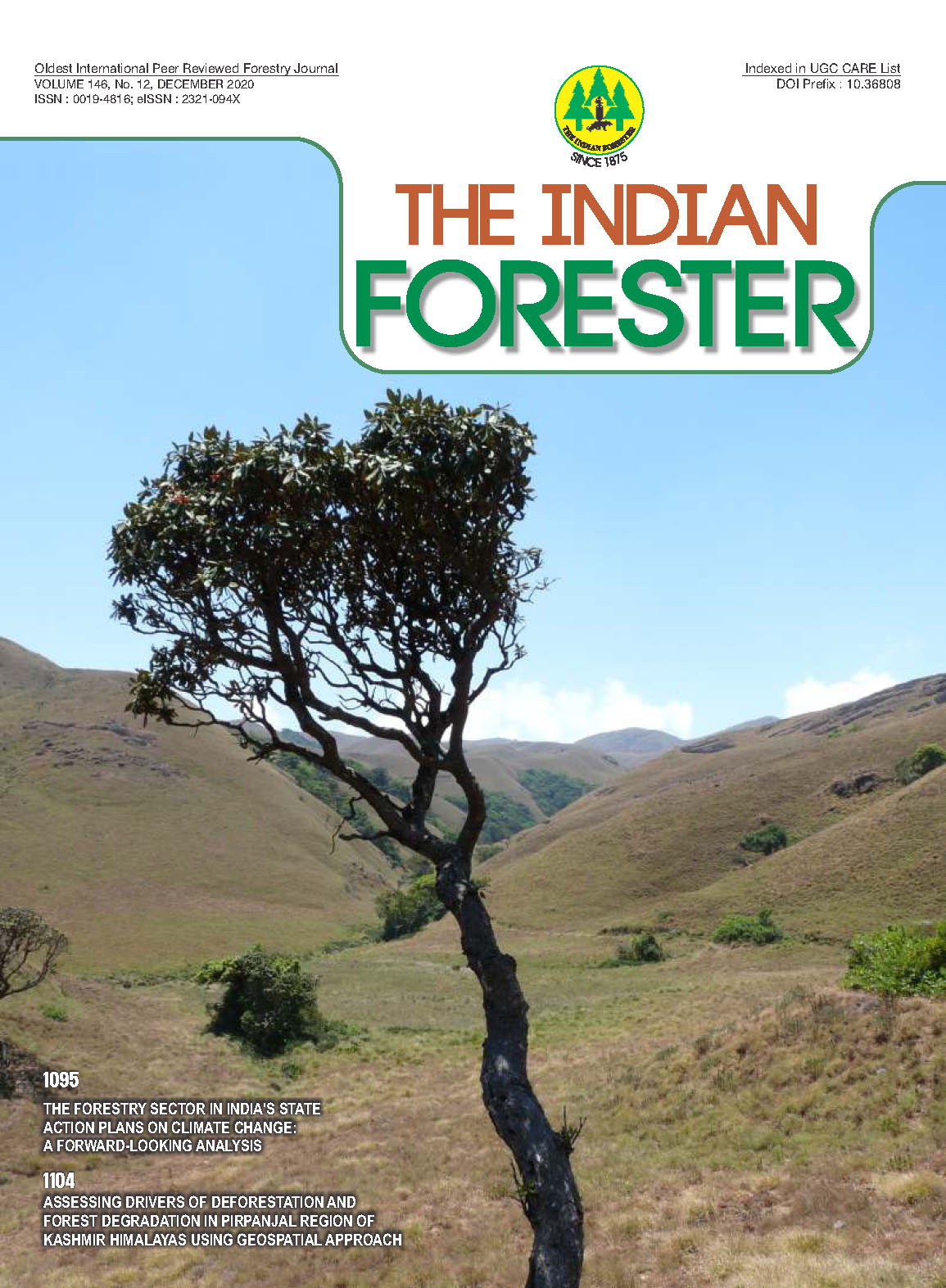Screening of Selected Hosts for Sandalwood Seedlings at Nursery Stage Based on Host Cation Exchange Capacity
DOI:
https://doi.org/10.36808/if/2020/v146i12/156773Keywords:
Cation Exchange Capacity, Primary Host, Sandalwood Seedlings, Hemi-Root Parasite, Host Use Efficiency.Abstract
Cation exchange capacity (CEC) of host is a well-recognized criterion to establish the suitable hosts for sandalwood. An experiment for nine months was laid down to find suitableprimary hosts on the basis of CEC of host root, morphology, host use efficiency (HUE) and biomass of sandalwood at seedling stage in the nursery of Institute of Wood Science and Technology, Malleshwaram, Bengaluru, with 10 treatments (different hosts including control), 3 replications in Complete Randomized Design (CRD). Based on preliminary data, increased and decreased CEC values of host roots were categorized as A and B, respectively. Results indicated that after being parasitized, decreased CEC of host root (category B) possibly increased the HUE of sandalwood seedlings consequently, increased its biomass in comparison to hosts belonged to category A (increased CEC) in nursery condition. Among these treatments, T4 (Santalum album + Alternanthera ficoidea), T5 (Santalum album + Aerva sanguinolenta) and T8 (Santalum album + Mentha arvensis L.) were good primary hosts for sandalwood seedlings belonged to category B. This indicated that hosts with decreased root CEC may not always poor as reported previously. The observations also validated the fact that primary hosts are necessary for sandalwood seedlings at early nursery stage to achieve better growth.References
Ananthapadmanabha H.S., Nagaveni H.C. and Rai S.N. (1988). Influence of host plants in the growth of Sandal. My Forest, 24(2): 154-160.
Annapurna D., Rathore T. S. and Joshi Geeta (2006). Modern Nursery Practices in the Production of Quality Seedlings of Indian Sandalwood (Santalum album L.). Stage of Host Requirement and Screening of Primary Host Species. Jr. of Sustainable Forest, 22(3/4): 33-55.
Barrett D.R. and Fox J.E.D. (1995). A protocol suitable for raising seedlings of Santalum albumin Timor. In: Sandalwood Seed Nursery and Plantation Technology, FAO, Suva, Fiji. RAS/92/361. Ed. Gjerum L., Fox J.E.D. and Ehrhart L. Field Document, 8: 163-164.
Chakraborty Sandeep, Manjunatha L. and Viswanath S. (2019). Simple unconventional methods to control powdery mildew in sandalwood seedlings. My Forest, 55(1): 1-6.
Fritz Eberhard (2007). Measurement of Cation Exchange Capacity (CEC) of Plant Cell Walls by X-Ray Microanalysis (EDX) in the Transmission Electron Microscope.Microsc. Microanal. 13: 233-244.
Haynes R.J. ~(1980). Ion exchange properties of roots and ionic interactions within the root apoplasm: Their role in ion accumulation by plants. Bot Rev., 46: 75-99.
Iyengar A.V.V. (1960). The relation of soil nutrients to the incidence of spike disease in sandalwood (Santalum album L.). Indian Forester, 86: 220-229.
Lukowskal Malgorzata and Zefaciuk Jo G. (2016). Osmotic stress induces severe decrease in cation exchange capacity and surface groups of medium acidity in roots of cereal plants. Acta Physiol Plant, 38:31.
Mitsui Singo and Ueda Minoru. (1963). Cation Exchange Capacity of crop roots in relation with ion uptake. Soil Sci. and Plant Nutrition, 9(1): 6-12.
Nagaveni and Vijayalakshmi (2003). Growth performance of sandal with different host species. Sandal Research newsletter, 18: 1-2.
Nagaveni H.C. and Srimathi R.A. (1985). A note on hautoria Less Sandal Plants. Indian Forester, 3(3): 161-163.
Parthasarathi K., Gupta S.K. and Rao P.S. (1974). Differential response in the cation exchange capacity of the host plants on parasitization by sandal (Santalum album Linn.). Curr. Sci. 43(1): 20-20.
Radomiljac A.M. and McComb J.A. (1998). Alternanthera nana R. Br. nursery sowing-Time influences Santalum album L. growth following field planting. In: Sandal and its products. Proceedings of an International seminar, held on 18-19 Dec. 1997, Bangalore, India. Edited by Radomiljac, A.M., Ananthapadmanabha, H.S., Welbourn, R.M. and Satyanarayana Rao, K.S. ACIAR.pp. 188-191.
Radomiljac A.M. (1998). The influence of pot host species, seedling age and supplementary nursery nutrition on Santalum album L. (Indian Sandalwood) plantation establishment within the Ord River irrigation area, Western Australia. For. Eco. and Management, 102: 193-201.
Radomiljac. A. M., Jen A. McCombb, John F and McGrath, (1999). Intermediate host influences on the root hemiparasite Santalum album L. biomass partitioning. For. Eco. and Management, 113: 143-153.
Rai S.N. (1990). Status and cultivation of sandalwood in India. In: USDA Forest Service general Technical Report PSW-122: 67-71.
Ram L.C. (1980). Cation exchange capacity of plant roots in relation to nutrient uptake by shoot and grain as influenced by age. Plant and Soil, 55: 215-224.
Ramaiah P.K., Parthasarathi K. and Rao P.S. (1962). Studies on Sandal spike: A histochemical study of sandal root haustoria in relation to nutrition. In. Proc. Indian. Acad. Wood Sci., 56B: 111-113.
Rangaswamy C.R., Ananthapadmanabha H.S., Jain S.H. and Nagaveni H.C. (1986). Nutrient uptake and host requirement of Sandal. Van Vigyan, 24: 75-79.
Sattelmacher B., Mühling K.H. and Pennewiss K. (1998). The apoplast -Its significance for the nutrition of higher plants. J. Plant Nutr Soil Sci., 161: 485-498.
Scot J. (1871).Notes of horticulture in Bengal. No. 2, Loranthacease, the mistletoe order, their germination and mode of attachment. Jr. Hort. Soc., 2: 287.
Srimathi R.A., Kulkarni H.D. and Venkatesan K.R. (1961). Recent advances in Research And Management of Sandal (SantalumalbumL.) in India. Edited by Srimathi R.A., Kulkarni H.D. andVenkatesan K.R. New Delhi, pp. 416.
Srinivasan V.V., Sivaramakrishnan V.R., Rangaswamy C.R., Ananthapadmanabha S. and Shankaranarayana M.H. (1992). In: Sandal (Santalum album L.). Published by the Director, Institute of Wood Science and Technology (ICFRE), Bangalore, India. pp. 232.
Surata K. (1992). Effect of host plants on growth of Sandalwood (Santalum album) seedlings. Santalum, 9: 1-10.
Downloads
Downloads
Published
How to Cite
Issue
Section
License
Unless otherwise stated, copyright or similar rights in all materials presented on the site, including graphical images, are owned by Indian Forester.





